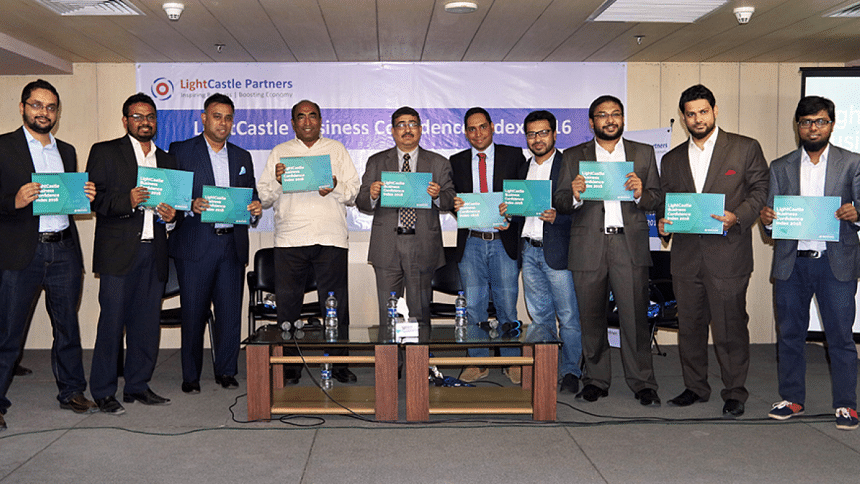LightCastle Partners rank Bangladesh's Business Confidence Index

The report was launched yesterday at The Daily Star, Strategic Partner of this initiative. Mamun Rashid, Managing Partner, PwC Bangladesh; Niaz Rahim, Group Director, Rahimafrooz; and Masrur Reaz, Program Manager, Trade & Competitiveness, IFC Bangladesh, spoke at the event.
The goal of the report is to quantify the prevalent business sentiments lending voice to the private sector business community, by aggregating their views in the form of a report. And this index is particularly interesting in the context of our country's shift towards a middle income status.
The study aims to understand the factors that influence the business ecosystem through a collection of facts, figures and opinions of our business community. It presents the status quo, identifies the challenges confronting growth and recommends action items to lever up the index in the coming years.
METHODOLOGY
The Harmonised Expectation Indicator (HEI) method was used to process the index score. This factors in performance reviews for the foregone year, current situation and expectations for the upcoming year. Firm level representation was carefully selected to be reflective of the respective industries. Industry representation was organised to be proportional to their respective contribution to GDP. All surveys were fielded in June-July, 2016.
IMPACT OF THE STUDY
Bangladesh's remarkable private sector growth over time has brought into limelight the significance of having a confidence index that plays an important role in investors' decision making framework for foraying new sectors or expanding existing ones. The BCI can potentially indicate conditions of current business environment, which will provide further clarity for both domestic and foreign investors.
This will also serve as a manual for the business leaders to understand the underlying economic challenges and opportunities. With superior access to information, they can simplify their decision making process, plan better and execute timely to increase their foothold in their respective markets. Finally, the report will draw attention of the policy makers to put more effort and resources into the most pressing areas as determined by the business leaders.
KEY INSIGHTS
The sectors that have scored highly include Information Technology (92%), followed by Healthcare (67%), RMG (63%) and Financial Institutions (56%). Industry leaders have cited incremental growth in the export of high-value products, recent political stability and an increase in purchasing power as the main driving factors behind their positive outlooks.
41% of the respondents have higher export expectations in the coming year thanks to the recent infrastructures development, while 43% opine export figures will remain unchanged due to power & gas shortages and inefficiencies in port management. In fact, 100% of the respondents cited energy shortages as a major deterrent to optimism.
96% of the business leaders feel that there's a big skills gap in their workforce. Respondents feel that a stronger recruitment pipeline from universities, heavier investment on training and retaining workers and better education systems are required to solve this critical problem. More than 72% of the industry leaders feel confident that they will be able to create more employment for the youth if the above tactics are effectively put into place.
Connecting academic research to commercial applications came up as strong recommendation from the business leaders. Many academic institutions are conducting cutting edge research across various sectors, noticeably in renewable energy and agriculture. However, many respondents complained that these R&D efforts often fail to reach the hands that could apply these concepts at scale. If universities and the private sector partner more often, then it could be a potential win-win situation for both parties. Universities will get more opportunities to finance their research while employers can apply these findings and simultaneously make deeper inroads in the recruitment pipeline.
The major problem areas cited by the industry leaders are employee incompetency (96%), absence of standardisation of regulatory bodies (73%), inefficient logistics (61%) and financing constraints (53%). Perhaps these sentiments can be best summed up in the words of one of the respondents, who said, "The optimism comes more due to the absence of darkness, rather than the presence of light."
Industries that are deemed as the highest growth opportunities in the coming decade are: Power & Gas, Information Technology & Ready Made Garments.
CONCLUSION
Industry leaders are not overwhelmingly optimistic regarding the economic performance for the coming year. However, they are not completely cynical either. They feel the optimism will increase if the following are considered:
-Prioritising political stability and security;
-Facilitating domestic and foreign investment in the manufacturing sector;
-Increasing rewards and recognition in tax payments;
-Incentives for export once domestic demand is met;
-Greater connection between academic research with commercial applications.
Our country is at a crucial juncture where we can capitalise on the demographic dividend and strategic geographical position to become the next Asian Tiger. Therefore, identifying and analysing patterns in the macro-economy, taking the perspectives of business leaders over multiple periods will equip us with superior information, eventually leading to new avenues of opportunities in Bangladesh.
To learn more about the industry specific insights, you can download the report for free from LightCastle's report portal at: www.lightcastledata.com/drive.

 For all latest news, follow The Daily Star's Google News channel.
For all latest news, follow The Daily Star's Google News channel. 



Comments